How to Make Macaroni Grill Mac and Cheese
I have a confession to make. I didn't grow up on macaroni cheese. Search as I might, I can locate no fond memories of my mother serving up a bubbling bowl of the stuff on Sunday evenings, or even fobbing us off with the infamous Kraft version so beloved across the pond. I have an inkling (best not explored) that it would occasionally put in an appearance in the school canteen, but it always puzzled me that, despite being largely made up of two of my very favourite ingredients, pasta and cheese, with no tomato to lend a spurious suggestion of health, I never took to the stuff.
This, then, is my own personal mission of conversion. Everyone loves macaroni cheese. Marlene Spieler has written a whole book about the stuff. America boasts more than one restaurant serving nothing else. Guardian wine writer and cheese fiend Fiona Beckett was deluged with entries when she launched a mac and cheese competition on her website a couple of years ago.
Whatever its alleged southern-Italian roots, it's a dish which we can safely embrace as an Anglo-American classic, which means I can merrily throw all notions of "authenticity" to the wind, and simply go with whatever tastes best.
For the sake of my own sanity and waistline, however, I've decided to stick to plain macaroni and cheese here, rather than exploring any of the near infinite variations on the theme – you can try out Thai red curry mac and cheese on your own time.
Mum's version
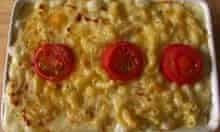
In the absence of any advice from my own mum, I turn to chef Tom Norrington-Davies' handy collection of maternal recipes, Just Like Mother Used to Make. He reckons that "simplicity is the key to macaroni cheese... nothing should leap out at you except a clumsy, gooey richness". There's no cream or spice here: just a plain white sauce, a modest amount of cheddar, and some pasta. The only concession to frippery is the vivid red grilled tomatoes that Norrington-Davies mère liked to top the dish with.
Although deliberately and undeniably bland, I find the dish oddly comforting: creamy, but not oppressively rich, faintly cheesy, the dominant taste is those sweetly caramelised tomatoes. This is nursery food extraordinaire.
Mater's posh version
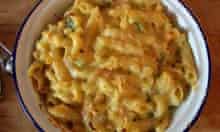
After pointing out that there's "very little to get wrong here", Simon Hopkinson and Lindsey Bareham deliver a googly in The Prawn Cocktail Years by calling for penne, rather than macaroni "because the cheese sauce is better able to flow inside this larger-sized pasta". A few pointers, they insist, "will help to make this familiar yet sometimes disappointing dish into superior comfort food."
One is the pasta. The other is, that because "almost all the joy of eating Macaroni Cheese comes from its creamy sauce", it's worth "going to town" on the seasoning and an "assertively flavoured" cheese. This means infusing the milk with a bay leaf and black pepper before making the white sauce, and then adding a mature Lancashire cheese, as well as a slug of double cream. Bolder still, they suggest chucking in some sliced onion or leeks, softened in a little butter, along with a small bunch of chopped chives along with the sauce and pasta.
It's all very refined, down to the parmesan topping, but I miss the velvety texture of the plain white sauce, and find the onion too bullyingly dominant: macaroni cheese should be something one could happily eat in bed, should opportunity call, and alliums and pillows should never mix.
Decadence
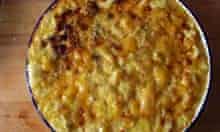
Most of the entries to Fiona Beckett's aforementioned Ultimate Macaroni Cheese challenge (won by Helen Graves with a fabulous ham hock concoction) included some cunning, but unorthodox new ingredient, like pork, or beer, or even chocolate, putting them sadly outside my classic remit.
Kirsten Rogers, aka Ms Marmite Lover, however, qualified with an outrageous but nonetheless simple recipe which employs twice as much double cream as white sauce (Simon and Lindsey, take note: this is how you tart up macaroni). The end result is delicious, yet so intensely rich that it can only be consumed in the most elegant of portions: the kind of comfort food which demands silk sheets and cashmere dressing gowns. Which is not exactly what I'm after.
Victorian version
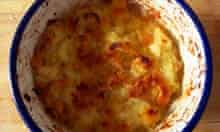
It makes sense then, to turn to my trusty Mrs Beeton for a recipe, and she doesn't disappoint, with directions for macaroni "as usually served with the cheese course", as well as as distinctly less pleasant sounding sweet milk pudding made with the stuff.
It has little in common with anything I've made so far, but ticks a fair few boxes in the iSpy book of Victorian cooking cliches by instructing me to cook the macaroni, in a pan of milk and water, for 1½ to 1¾ hours, until "quite tender". After a mere hour at a "quick boil", my pan boils dry, and I'm forced to move on to the next stage of the recipe, tipping the gluey mass into a dish, and sprinkling with a quite impressive amount of parmesan cheese and butter.
The macaroni, (which should be "tender but perfectly firm, no part being allowed to melt, and the form entirely preserved" – lest one be tempted to cook it for so long it actually disintegrated) is then topped with more cheese, pepper and breadcrumbs, before receiving a final dose of melted butter for good measure and being placed before a "bright fire" to brown the crumbs, or grilled with a salamander ("more expeditious" apparently, but I make do with an electric grill). If not the prettiest of dishes, it's oddly satisfying, in an intensely cheesy, gloopy, buttery sort of way. Comfort food hasn't changed much, it seems.
Greasy mac
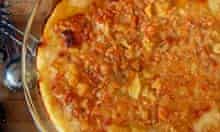
While cruising mac and cheese forums online (I promise I haven't made these up), I notice one recipe comes up more than any other: Martha Stewart's "crack and cheese", so named because of its alleged addictive qualities. America's only slightly tarnished domestic goddess seems an obvious choice for a killer mac recipe – in all senses, given the amounts of cheese and butter involved.
After a brief, and patriotic lecture on the history of the dish, Martha opines that, "making it more comforting, cheesier" is "a completely worthwhile way to spend your time." She seems to have done a lot of work on the latter objective: I have to put an entire large block of cheddar in, and a sizeable slab of gruyère. This mac is making me feel slightly queasy already, but nevertheless, I soldier on.
Although it looks dreamy – all golden breadcrumbs and bubbling, creamy sauce, on the plate, the dish is a disappointment. All that cheese has made the sauce greasy and slightly grainy, and aggressively sharp, rather than comforting.
Cheese and macaroni
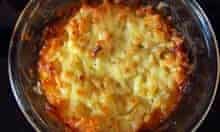
The more macaronis I make, the more I warm to Tom Norrington-Davies' plain and simple, and very British version, with its blandly familiar white sauce, so I approach my final recipe with a certain trepidation. Julia Moskin, on a quest for the perfect mac and cheese in the New York Times, sets out her stall with a quote from food writer John Thorne on the subject: "A good dish of macaroni and cheese is hard to find these days. The recipes in most cookbooks are not to be trusted ... usually it is their vexatious infatuation with white sauce, a noxious paste of flour-thickened milk, for this dish flavored with a tiny grating of cheese. Contrary to popular belief, this is not macaroni and cheese but macaroni with cheese sauce. It is awful stuff and every cookbook in which it appears should be thrown out the window."
Moskin is obsessed with the idea of cheese, admitting her fantasy macaroni is "nothing more than tender elbows of pasta suspended in pure molten cheddar, with a chewy, golden-brown crust of cheese on top." When in doubt, Julia suggests, "add more cheese". Although her recipe for "creamy macaroni and cheese" scares me, I'm intrigued by the fact she doesn't pre-cook the macaroni or make a white sauce, so I swallow hard and give it a whirl.
The liquid in the dish is a mixture of pureed cottage cheese and milk, seasoned with cayenne, mustard powder and nutmeg, and poured over the dry pasta. Covered tightly with foil, the pasta soaks up the liquid in the oven, leaving it cooked, but with little in the way of the creaminess promised in the title – it's dense and cheesy, with a crunchy top of baked pasta which threatens to break my teeth. This is not my idea of comfort food.
Cheese and other stories
I've used a variety of cheeses in my experiments; parmesan, as espoused by Mrs Beeton, is too aggressively strong. Simon and Lindsay's Lancashire, on its own, is too lactic and sharp – I like the sweet nuttiness of the gruyère that Martha uses, but it's overpowered by her "sharp white cheddar".
Instead, I go for a nuttier, more mature cheddar that works perfectly with the pinch of nutmeg which is the one concession to spice I'm allowing – it's sweet and comforting, rather than hot, or sour like the mustard that Kerstin and many others include. English mustard powder however, adds a subtle kick without any accompanying acidity.
The copious amounts of garlic Jamie Oliver throws into his "killer mac n' cheese" in Jamie's America jars like the onion in the Prawn Cocktail Years recipe: macaroni cheese should slip down easily, it's not about strong flavours. Grilled tomatoes and Martha's buttered breadcrumb and cheese mixture are enough to save the dish from blandness without stealing the limelight from the pasta, although I've substituted parmesan for the cheddar on top – its salty savouriness is more welcome in small amounts.
Penne or rigatoni is often suggested as a substitute for the macaroni, as per Simon and Lindsey, but here, I think, it works perfectly: the pieces are small enough to not need cutting and to allow a satisfying volume in the mouth. (Also, it can be eaten with a spoon, which is the final proof of great sofa food.) I like Martha's advice about rinsing the starch off before adding the pasta it to the dish: it helps to keep it separate, rather than clumped together in one gluey mass.
Perfect macaroni cheese
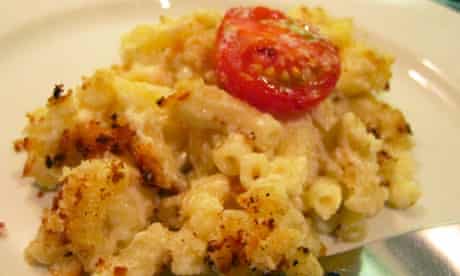
Macaroni cheese is all about familiarity and comfort: introducing strong flavours like onion, or parmesan, while undoubtedly delicious, misses the point. It should be subtly cheesy, creamy and soft – not too dense, or modishly al dente, it's a dish that embraces the Victorian values of modesty and quiet, plain simplicity.
Serves 2
200g macaroni
35g butter, plus extra for greasing
25g plain flour
450ml whole milk
Grating of nutmeg
½ tsp English mustard powder
50g mature cheddar
1 slice of white bread, made into crumbs
1 tbsp grated parmesan
2 tomatoes, halved
1. Cook the macaroni in plenty of salted boiling water until tender. Meanwhile, melt 25g of the butter in a pan, and stir in the flour. Cook, stirring, for a couple of minutes, then gradually whisk in the milk until you have a smooth sauce. Cook, stirring, for a few minutes until it thickens, then add a grating of nutmeg and the mustard and stir in the cheddar until smooth. Take off the heat, and season to taste.
2. Pre-heat the grill. Drain the macaroni and rinse under cold running water. Grease a baking dish with butter, then combine the pasta and cheese sauce and tip into the dish.
3. Melt the remaining butter and then toss it together with the breadcrumbs and the parmesan. Spread over the top of the dish, then arrange the tomatoes, cut-side up, on top. Grill for about 10 minutes until golden and bubbling. Allow to stand for five minutes before serving.
Is macaroni cheese classic comfort food, or bland pap for Victorian palates? Do you prefer the outrageously cheesy, American style, or the more understated British dish – and will anyone come out and proudly admit they prefer the packet version?
How to Make Macaroni Grill Mac and Cheese
Source: https://www.theguardian.com/lifeandstyle/wordofmouth/2011/oct/06/how-to-cook-perfect-macaroni-cheese